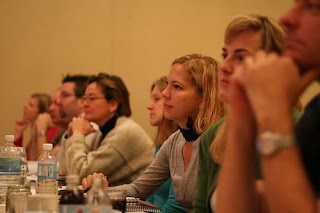An emphasis on fitness is different from merely increasing unstructured play time or adding more days of dodgeball into the schedule. (Forgive me, PE Teachers. I know that many of you do not consider dodgeball to be a beneficial way to spend a physical education class. I’m speaking to the erroneous perception, not your work!)
Dr. John Ratey, who literally wrote the book on this subject, uses a school in Naperville, IL to illustrate an emphasis on fitness. During one physical education session Ratey observed, students ran a mile while wearing heart rate monitors. In addition to completing the distance, students focused on reaching a target heart rate and on improving their times recorded in earlier previous sessions. Ratey then explains this focus:

The essence…is teaching fitness instead of sports. The underlying philosophy is that if physical education class can be used to instruct kids how to monitor and maintain their own health and fitness, then the lessons they learn will serve them for life. And probably a longer and happier life at that. What’s being taught, really, is a lifestyle. The students are developing healthy habits, skills, and a sense of fun, along with knowledge of how their bodies work…[The] effects [of this emphasis] have shown up in some unexpected places—namely, the classroom.1
Sure, I’m concerned about the childhood obesity rate (estimates put the number around 23 million children in the US—more than thirty times the number during my youth). Being overweight influences movement, both physical AND cognitive, and it’s this latter impact that interests me.
Consider these recent findings:
Fit children possess more of the neural geography used in learning and thinking. For example, in-shape children have “significantly larger basal ganglia, a key part of the brain that aids in maintaining attention and ‘executive control,’ or the ability to coordinate actions and thoughts crisply.”2 (Executive function is “an umbrella term for the complex cognitive processes that serve ongoing, goal-directed behaviors,” including goal setting, planning, organizing and initiating behavior over time, flexibility, attention, working memory capacity, and self-regulation. It comprises abilities to plan for the future, control impulses, and make sense of incoming data.3) In a similar study, fit children possessed larger hippocampi—more than 10% larger— and scored significantly higher on tests of associated memory than their less fit peers. (The hippocampus is a brain structure associated with memory, both encoding and retrieval.) The researchers concluded that “interventions to increase childhood physical activity could have an important effect on brain development.”4 In short, fitter children develop brains with the potential for better learning and thinking.
Childhood fitness also affects capacities that uphold and empower learning. For example, children engaged in regular fitness activity score higher on tests of self-regulation, an executive function that provides critical support for learning. Self-regulation is the ability to consciously suppress or delay responses in order to work for a higher goal. It predicts academic success better than IQ. It also better predicts GPA, standardized test achievement, homework completion, the potential for GPA gains during the course of a year, and even SAT scores. Self-regulation is like the support struts of a bridge; it is not the roadway to learning, but without it, an individual lacks the emotional and cognitive control that optimize learning. Researchers have also discovered relationships of fitness and academic achievement. A recent study focused on students representing four different categories: 1) children who possessed high physical fitness levels in fifth grade and maintained those levels in seventh grade, 2) students who were fit in fifth grade but lost their fitness by seventh grade, 3) students who were not fit in fifth grade but were physically fit by seventh grade, and (sadly) 4) students who were not physically fit in fifth grade and remained not fit in seventh grade. In reading, math, science and social studies, the fit in fifth, fit in seventh group outscored their peers. The students who gained fitness between fifth and seventh grades had the second best scores. The students who lost fitness from fifth to seventh grades had the next to lowest scores, with the never fit group scoring the lowest. Researchers conclude that physical fitness actually shows up in academic performance.5 Schools minimizing physical education classes to spend more time on academic subjects may actually dampen the academic performance of their students.
However, not all types of fitness show similar results. Teenage boys with higher cardiovascular fitness outperformed their peers in intelligence, education, and even income as adults. The researchers from this study stress the importance of cardiovascular fitness: “In every measure of cognitive functioning they analyzed—from verbal ability to logical performance to geometric perception to mechanical skills—average test scores increased according to aerobic fitness.”6 Weight training alone did not provide the same effect.
 What do we do with such convincing evidence—evidence that suggests the best tool to improving learning may be a pair of running shoes for each child? What do we need to change besides perceptions and schedules? Since physical movement seems to improve cognitive “movement,” how do we help our students get smarter by moving more?
What do we do with such convincing evidence—evidence that suggests the best tool to improving learning may be a pair of running shoes for each child? What do we need to change besides perceptions and schedules? Since physical movement seems to improve cognitive “movement,” how do we help our students get smarter by moving more?I’m going to ponder these questions as I head out for a run. Anyone care to join either the run or conversation? Looking forward to your comments! For now, I’ll give John Ratey the last word:
The notion that [fitness can influence learning] is supported by emerging research showing that physical activity sparks biological changes that encourage brain cells to bind to one another. For the brain to learn, these connections must be made; they reflect the brain’s fundamental ability to adapt to challenges. The more neuroscientists discover about this process, the clearer it becomes that exercise provides an unparalleled stimulus, creating an environment in which the brain is ready, willing, and able to learn…”7.
References
- Ratey, J., SPARK: The Revolutionary New Science of Exercise and the Brain (New York: Little, Brown & Co., 2008), 12.
- Parker-Pope, T., Phys Ed: Can Exercise Make Kids Smarter? http://well.blogs.nytimes.com/2010/09/15/phys-ed-can-exercise-make-kids-smarter/?emc=eta1
- Meltzer, L., Executive Function in Education: From Theory to Practice (New York: Guilford Press, 2007), 1.
- ScienceDaily., Children's Brain Development Is Linked to Physical Fitness, Research Finds. http://www.sciencedaily.com/releases/2010/09/100915171536.htm.
- ScienceDaily., Students' Physical Fitness Associated With Academic Achievement; Organized Physical Activity. http://www.sciencedaily.com/releases/2010/03/100302185522.htm.
- ScienceDaily., Fit Teenage Boys Are Smarter—But Muscle Strength Isn't the Secret, Study Shows. http://www.sciencedaily.com/releases/2009/12/091207143351.htm.
- Ratey, 10.
- ‘Running Shoes’ http://www.flickr.com/photos/64015205@N00/46324600
- ‘Morro Bay, CA High School Physical Education+class+-+teen+girls+run+up+and+down+the+Morro+Strand+State+Beach’ http://www.flickr.com/photos/72825507@N00/3253894179











